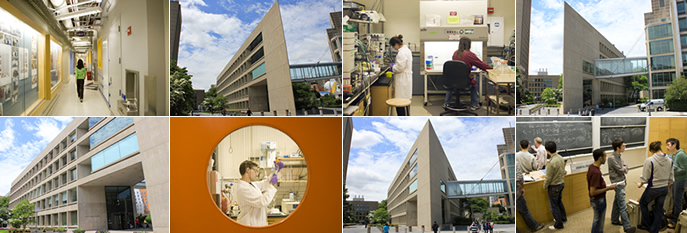Building 66 Renovation
A tour through Building 66 is a floor-by-floor introduction to the astonishing reach of chemical engineering today. The second floor: research into energy storage, manufacturing, and drug delivery. The fourth floor: paper solar cells, water purification, and fuel cells. The fifth floor: biological sensors, new routes to pharmaceutical manufacturing, nanoparticle synthesis and delivery, and new applications of graphene. With the undergraduate teaching laboratory in the basement and Practice School headquarters on the third floor, the building is not only home to cutting-edge research, but also the training ground for the students who will shape the future across many disciplines— addressing the challenges of modern society including health, energy, food, and water.
Today, Course 10 is at the heart of MIT in many dimensions—but the vessel that carried the department to its current prominence has lagged behind. We now seek to perform renovations to create modern laboratories equal to current research interests, to meet the highest industry standards for safety, and to support the department in its work as the top-ranked program in the world.
The Need
Renovations will encompass half of the building’s total footprint, including every floor and all building operations. Improvements will impact space related to every resident member of the Chemical Engineering faculty and 80 percent of the current student space.
The project will:
▪ Modernize 14 laboratories to reflect the experimental and design-oriented range of research conducted by today’s faculty and students
▪ Elevate safety standards building-wide through new design and upgrading infrastructure and equipment
▪ Provide new facilities to reflect the growing number of women at MIT
▪ Redesign all faculty offices for a more efficient, egalitarian use of space that fits how the department operates today
▪ Provide offices for graduate students distinct from the laboratory areas
▪ Create an undergraduate lounge and meeting space to encourage formal and informal interactions that support a strong learning community
▪ Tint exterior windows to reduce solar load, which will create a more stable interior climate and provide more consistent working conditions throughout the day
▪ Fully upgrade building systems, including heating, lighting, and ventilation
For more information, contact:
Jale Okay
Senior Leadership Giving Officer
jaleokay@mit.edu
617.715.2960
Kristala L. Jones Prather
Arthur Dehon Little Professor and Department Head
Department of Chemical Engineering
Massachusetts Institute of Technology
kljp@mit.edu
617.253.1950


